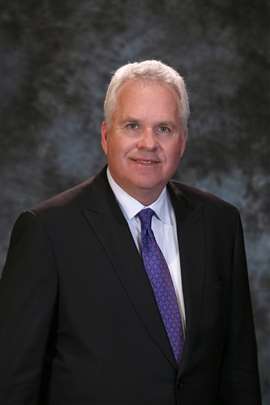Interview: Why a US construction body has started a legal battle with Biden
24 November 2023
After 27 years as chief executive of US-based trade association AGC, lawyer Stephen Sandherr is finally calling it a day. He talks Lucy Barnard through the highs and lows of his long career - and why his final challenge is a legal fight with Joe Biden.
Stephen Sandherr leans back in his chair in his spacious office in Arlington Virginia and nods slowly.
“People ask me what’s the best part of your job,” says Stephen Sandherr, long time chief executive of US contractors trade association, Associated General Contractors, looking carefully into the laptop camera on our Teams call. “And I say winning.”
“For us it’s winning at everything that we try in our advocacy efforts,” Sandherr says. “Winning in our educational programmes. Winning at being advocates for the industry.”
 Stephen Sandherr. Photo: AGC
Stephen Sandherr. Photo: AGC
Last month Sandherr hit the headlines when, AGC, and fellow construction industry trade organisation, Associated Builders & Contractors, both filed separate lawsuits against the US government aiming to block it from rewriting construction labour regulations contained in the 1931 Davis-Bacon Act which the Biden administration says would change pay standards on federal construction projects.
The new rule, announced by US vice president Kamala Harris in August, would require employers to pay construction workers the equivalent of wages paid to at least 30% of workers in a given trade and locality.
Citing a heavy-equipment operator on federally funded construction projects in Allegheny County in Pennsylvania who would see his pay increase to $28 an hour from $17, Harris said the changes would “give workers across the nation a raise,” (see box)
Sandherr disagrees. He argues that the move would increase regulatory burdens on small businesses and has been designed to extend to industries not covered by the original legislation. Others hint that the move is a cynical political move to attract union support ahead of next year’s presidential election.
“As an industry that largely pays above existing Davis-Bacon rates, our concerns are with the administration’s unconstitutional exercise of legislative power and not with the wage rate themselves,” Sandherr says. “But we are challenging the fact president’s unlawful efforts to expand a construction wage law to cover a wide range of manufacturing and shipping operations.”
So, does Sandherr believe the US construction industry would fare better under the other lot - a Trump presidency rather than a Biden one? According to OpenSecrets, a non-profit organisation which tracks campaign funding and lobbying, although AGC has donated significant amounts to both Republicans and Democrats over the years, overall the Republicans tend to receive a bigger share of political donations.
“We are not a partisan organisation; we are a business organisation. We look to work with people that want to work with us,” says Sandherr. “Whoever is our next president will have to figure out a way to succeed and to win.”
AGC’s lobbying activities
According to OpenSecrets, the group has spent US$960,545 on lobbying activities and in 2022 it spent over $1m. By comparison, the larger Associated Builders and Contractors, which represents 22,000 commercial contractors, has spent $1.9m so far in 2023 and a total of $2.4m last year.
“Getting the ear of government has been more difficult than when I first got involved in this business,” says Sandherr. “On big issues in our country, Democrats and Republicans would find a way to work together to solve problems. Now the more common environment is that one team wants to make the other team look bad rather than solve problems. Both parties were guilty of that.”
“Politicians of both parties are completely ignoring the real driver of our debt - which is public entitlement programmes like Social Security,” Sandherr adds. “They don’t have the courage, to be honest about the impact that the cost of those projects will have our future and our ability to do the things that Americans are used to doing - which is to have a good quality of life and to be able to defend ourselves against those who wish to do us harm.”
Whatever the outcome of this latest legal battle over Davis-Bacon, it is likely to be Sandherr’s swan song. In November the 65-year-old announced that he plans to step down from the role when his employment agreement expires at the end of March 2024 with long term AGC chief operating officer Jeffrey Shoaf taking on the role.
 US vice president Kamala Harris. Photo: Reuters/ Leah Millis
US vice president Kamala Harris. Photo: Reuters/ Leah Millis
Sandherr’s 27-year reign has not been uneventful, spanning crises including the Great Financial Crisis in 2008 and more recently, the Covid pandemic.
“2008 was a big challenge, globally. It was a hard time. The only owner that had money to spend was the federal government and so there was a lot of interest in our members getting into that work despite the challenges that are involved,” Sandherr says. “Covid also was a very difficult because we were working to keep construction projects going by demonstrating that our member firms could employ and maintain safety protocols to reduce the spread of the coronavirus and in large part you know we were able to keep the construction projects going throughout Covid while many other industries had to shut down.”
As for the industry itself, Sandherr says that overall, during his tenure, he believes conditions have changed for the better; partly as a result of technological advancements and improvements in contract types such as public private partnerships, but also as a result of a fundamental shift in the relationships between employers and employees.
“The first part of that is contractors recognising they have both a legal and a moral responsibility to make sure that their workers are safe on the job,” he says. “And the other part is a transition from the old school - you know you have eight hours; you’ll be there eight hours; these are the rules.”
“Contractors have recognised that they have to be more flexible with their employees, particularly since it’s difficult to retain their employees. They have to be more cognizant of benefit packages that will help them recruit retain employees. They have to be focused on making sure they feel they belong, that everybody is an important member of a team and everybody is making contributions to that team and they should be rewarded for those contributions.”
Facing retirement
Nonetheless, as he personally faces retirement, Sandherr points out that many of the construction workers he represents are facing similar life changes with all-too-few younger replacements coming into the industry. In fact, he says that one of the major constants of his term in office has been the continuing shortage of skilled construction workers.
In September, an AGC survey found that 85% of about 1,400 contractor respondents said that they had current vacancies for skilled craftworkers and 88% of those said they had a “hard time” filling skilled craftworker positions. The results were slightly down on the previous year when the barometer showed 93% of companies reporting open positions and 91% of those struggling to fill them.
“In the 27 years I’ve been in this job, there’s only been one period. Where we didn’t have a workforce crisis and that was 2009 and 2010 when we had the Great Recession,” he says. “Contractors weren’t focused on finding workers, they were focused on finding work. That’s the only time. And if you look at the history of the AGC, we’re 105 years old and you can go back and look at board reports and board minutes and attracting workers to the industry has always been a challenge.”
Sandherr says that alongside its grass roots programmes of promoting the industry through each of its local chapters, AGC is also lobbying federal government to increase its budget for vocational training schemes and make it easier for new immigrants to work. Other major areas of focus include improving mental health support in the industry and attracting more women.
What is the Davis-Bacon Act - and why does it matter so much to construction workers?
The Davis-Bacon Act, which was passed in 1931, requires contractors on federally-funded public works to pay “the prevailing wage,” in an area. Before 1982, this was defined as the highest wage paid to at least 30% of workers. But in 1982, the Ronald Reagan government revised the definition to the wage paid to at least 50% of workers or the average. But unions say that non-unionised workers depress the average. So the Biden administration is reverting to the pre-1982 definition and making other technical tweaks to increase the wage floor.
STAY CONNECTED



Receive the information you need when you need it through our world-leading magazines, newsletters and daily briefings.
CONNECT WITH THE TEAM








